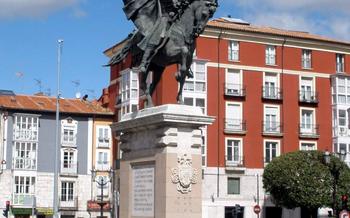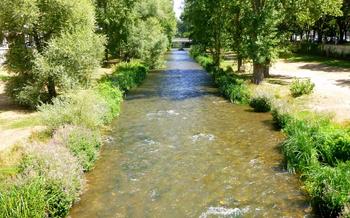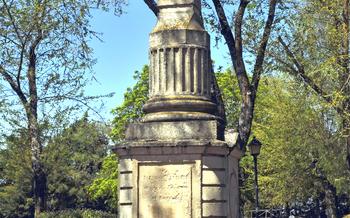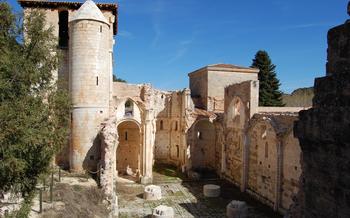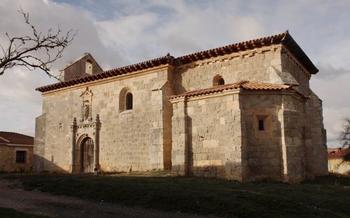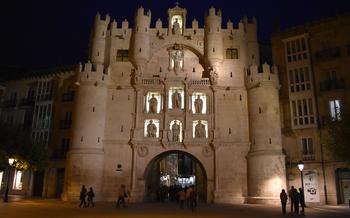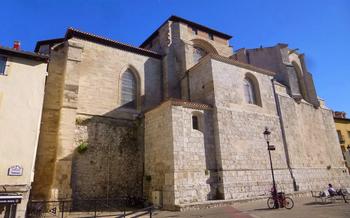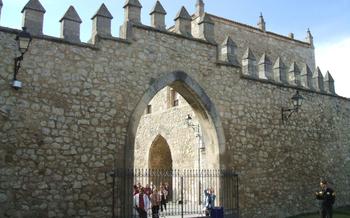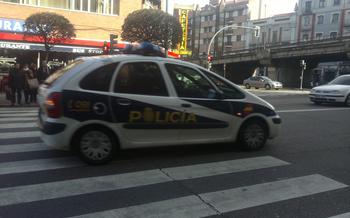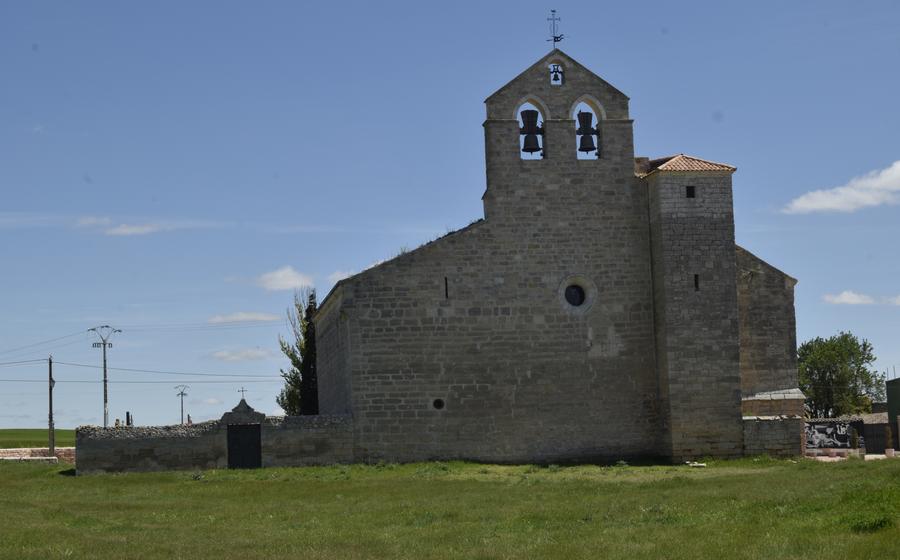
Iglesia de San Juan Bautista
- Burgos Cathedral
- Plaza Mayor
- Monastery of Las Huelgas Reales
- Museo de Burgos
- Casa del Cordón
- Arco de Santa María
- Iglesia de San Nicolás de Bari
- Museo de Arte Contemporáneo de Burgos
- Paseo del Espolón
- Parque del Castillo
- Monasterio de San Pedro de Cardeña
- Sierra de la Demanda
- Ruta del Vino de Arlanza
- Festival de Burgos
- Insider Tip
Burgos Cathedral
Burgos Cathedral, a UNESCO World Heritage Site, is an awe-inspiring masterpiece of Gothic architecture, standing tall and proud in the heart of the city. Its construction began in the 13th century, and it took over 300 years to complete, resulting in a harmonious blend of architectural styles. The cathedral's exterior is adorned with intricate carvings, flying buttresses, and soaring spires that reach towards the sky. Inside, visitors are greeted by a vast and luminous nave, supported by graceful columns and ribbed vaults. The stained-glass windows, depicting biblical scenes and saints, cast a kaleidoscope of colors onto the interior, creating an ethereal and sacred atmosphere. Among the cathedral's many treasures are the Chapel of the Constable, with its exquisite Renaissance altarpiece, and the Papamoscas clock, a mechanical marvel that chimes the hour with moving figures. Burgos Cathedral is not just a religious edifice but a testament to the artistic and architectural prowess of the Middle Ages, and a must-visit for anyone exploring the city.
Plaza Mayor
In the heart of Burgos' old town, the Plaza Mayor stands as a testament to the city's rich history and vibrant urban life. This central square, easily accessible from the city's main streets, serves as a gathering place for locals and visitors alike. The square is surrounded by elegant buildings with arcades and balconies, adding to its charm and grandeur.
The Plaza Mayor is dominated by the impressive equestrian statue of Charles III, a majestic monument that pays homage to the Spanish king who reigned during the 18th century. The statue, with its intricate details and regal presence, adds a touch of solemnity and grandeur to the square.
Monastery of Las Huelgas Reales
History and foundation of the monastery
The Monastery of Las Huelgas Reales, a beautiful and historic site in Burgos, Spain, was founded in 1187 by King Alfonso VIII and his wife, Queen Eleanor of England. The monastery was intended to be a royal pantheon, a burial place for the kings and queens of Castile, and a home for the Cistercian nuns who would pray for the souls of the deceased monarchs.
The Cistercian order and its influence
The Cistercian order, founded in the 11th century in France, was known for its strict adherence to the Benedictine Rule and its emphasis on simplicity, poverty, and manual labor. The Cistercians played a significant role in the development of medieval Europe, establishing monasteries throughout the continent and contributing to the spread of Christianity.
The Royal Pantheon and its tombs
The Royal Pantheon of the Monastery of Las Huelgas Reales is the burial place of several kings and queens of Castile, including Alfonso VIII, Eleanor of England, and their son, Enrique I. The pantheon is a beautiful and serene space, with elaborate tombs and effigies of the deceased monarchs.
The cloister and its architecture
One of the most striking features of the Monastery of Las Huelgas Reales is its cloister, a peaceful and secluded space surrounded by arcades and gardens. The cloister is a masterpiece of Gothic architecture, with intricate carvings and sculptures adorning its walls and columns. The cloister is a popular spot for visitors to relax and admire the beauty of the monastery.
Museo de Burgos
The Museo de Burgos is a must-visit for anyone interested in the rich history and culture of the city. Located in the heart of the old town, the museum houses a vast collection of artifacts that span from the Middle Ages to the present day.
The museum's medieval and Renaissance art collection is particularly impressive, with works by some of the most renowned artists of the period. Visitors can admire stunning paintings, sculptures, and tapestries that offer a glimpse into the artistic and cultural achievements of Burgos during this time.
One of the highlights of the museum is the El Cid Campeador room, dedicated to the legendary Castilian knight who played a crucial role in the Reconquista. Visitors can learn about El Cid's life and exploits through a variety of exhibits, including armor, weapons, and manuscripts.
The museum also hosts temporary exhibitions that showcase the works of contemporary artists and explore various aspects of Burgos' history and culture. These exhibitions offer a dynamic and engaging way to learn about the city and its people.
Casa del Cordón
The Casa del Cordón, located in the historic center of Burgos, is a magnificent example of Gothic and Renaissance architecture. Built in the 15th century by the wealthy Cordón family, the house served as a testament to their power and influence in the city.
Its most distinctive feature is the ornate Gothic façade, adorned with intricate carvings and sculptures. The Cordón family's coat of arms, featuring a knotted rope (cordón in Spanish), is prominently displayed above the doorway. The Renaissance courtyard, added in the 16th century, provides a striking contrast to the Gothic exterior, with its elegant arches and columns.
Inside, the house boasts a collection of stunning rooms, each with its own unique character. The Hall of Kings, for example, features portraits of Spanish monarchs, while the Hall of Mirrors is adorned with intricate mirrorwork and frescoes. The house is also home to a museum that showcases the Cordón family's history and the rich cultural heritage of Burgos.
Over the centuries, the Casa del Cordón has witnessed many important events and has been associated with numerous legends and stories. It is said that the house was once visited by King Ferdinand and Queen Isabella, who were so impressed by its beauty that they granted the Cordón family the privilege of adding a cord to their coat of arms.
Today, the Casa del Cordón is open to the public as a museum, offering visitors a glimpse into the opulent lifestyle of the Cordón family and the architectural treasures of Burgos.
Arco de Santa María
The Arco de Santa María is one of the most iconic landmarks in Burgos, Spain. It was built in the 14th century as a city gate and formed part of the city's defensive walls. The arch is an impressive example of Mudejar architecture, a style that combines Islamic and Gothic elements.
The Arco de Santa María is located in the heart of Burgos' old town, near the Plaza Mayor. It is a large, horseshoe-shaped archway with two towers on either side. The arch is decorated with intricate carvings and bas-reliefs that depict scenes from the Bible and the history of Burgos.
The Arco de Santa María is a popular tourist destination, and it is one of the most photographed landmarks in Burgos. Visitors can climb to the top of the towers for panoramic views of the city and the surrounding countryside. The arch is also a popular spot for weddings and other special events.
Here are some interesting facts about the Arco de Santa María:
- The arch was built in the 14th century by King Alfonso XI of Castile.
- It was originally called the Puerta de Santa María (Gate of Santa María).
- The arch was part of the city's defensive walls, which were built to protect Burgos from attack.
- The arch is an example of Mudejar architecture, which combines Islamic and Gothic elements.
- The arch is decorated with intricate carvings and bas-reliefs that depict scenes from the Bible and the history of Burgos.
- The arch is a popular tourist destination, and it is one of the most photographed landmarks in Burgos.
- Visitors can climb to the top of the towers for panoramic views of the city and the surrounding countryside.
- The arch is also a popular spot for weddings and other special events.
Iglesia de San Nicolás de Bari
The Iglesia de San Nicolás de Bari is a beautiful example of Plateresque architecture, located in the historic center of Burgos. Built in the 16th century, the church is known for its elaborate façade, which is adorned with intricate carvings and sculptures.
The interior of the church is equally impressive, with a nave and two aisles separated by rows of slender columns. The altarpiece, which dates back to the 17th century, is a masterpiece of Baroque art, with its gilded carvings and vibrant colors.
One of the most striking features of the church is the Cristo de los Milagros, a 13th-century wooden sculpture of Christ that is said to have performed numerous miracles. The sculpture is housed in a side chapel and is a popular destination for pilgrims and tourists alike.
The Iglesia de San Nicolás de Bari is a must-see for anyone interested in architecture, art, or religion. It is a beautiful and historic building that offers a glimpse into the rich cultural heritage of Burgos.
Museo de Arte Contemporáneo de Burgos
The Museo de Arte Contemporáneo de Burgos (Museum of Contemporary Art of Burgos) is a must-see for art enthusiasts visiting the city. Founded in 1984, the museum boasts a diverse collection of contemporary art from Spanish and international artists. The collection includes paintings, sculptures, installations, and photography, showcasing a wide range of artistic styles and techniques.
The museum's collection is housed in a former convent, the Convento de San Pablo, which has been beautifully restored and adapted to its new purpose. The museum's modern and minimalist interior provides a striking contrast to the historic building's exterior, creating a unique and immersive atmosphere for visitors.
One of the highlights of the collection is the Elías Querejeta Collection, which features works by some of the most renowned Spanish artists of the 20th century, including Pablo Picasso, Joan Miró, and Antoni Tàpies. The museum also hosts temporary exhibitions throughout the year, showcasing the work of emerging and established contemporary artists.
The Museo de Arte Contemporáneo de Burgos is not only a place to admire art but also a vibrant cultural center that offers a variety of educational programs, workshops, and events. The museum's mission is to promote contemporary art and make it accessible to a wide audience, fostering a greater appreciation and understanding of this dynamic and ever-evolving art form.
Paseo del Espolón
Located along the banks of the Arlanzón promenades in Burgos. This beautiful tree-lined boulevard stretches for over a kilometer and offers stunning views of the river, the city, and the surrounding countryside.
The Paseo del Espolón was created in the 19th century as a place for the city's residents to stroll, relax, and socialize. Today, it remains a popular gathering spot for both locals and tourists alike. The promenade is adorned with lush gardens, colorful flower beds, and elegant fountains. It is also home to several monuments, including the statue of El Cid Campeador, the city's most famous hero.
The Paseo del Espolón is a great place to take a leisurely walk, enjoy a picnic, or simply sit and admire the scenery. It is also a popular spot for cultural events, such as concerts, exhibitions, and markets.
Whether you're looking to soak up some sun, get some exercise, or simply enjoy the beauty of Burgos, the Paseo del Espolón is the perfect place to do it.
Parque del Castillo
Located on the hill overlooking the city of Burgos, the Parque del Castillo offers stunning panoramic views and a peaceful retreat from urban life. Visitors can wander through the gardens, pause by the fountains, and admire the monuments that dot the landscape. For those interested in history, the park is home to the remains of the old castle that once stood on this site. This magnificent fortress, built in the 9th century, was an important defensive structure for the city and played a key role in the Reconquista. Today, visitors can explore the ruins and imagine the battles that took place here.
In addition to its historical significance, the Parque del Castillo is a popular spot for recreation and relaxation. The park features a playground for children, as well as picnic areas and benches where visitors can rest and enjoy the scenery. For those looking to stay active, there are several walking and jogging trails that wind through the park, offering beautiful views of the city and the surrounding countryside.
Monasterio de San Pedro de Cardeña
Nestled amidst the tranquil landscapes of the countryside, approximately 10 kilometers from the city of Burgos, lies the Monasterio de San Pedro de Cardeña, a historical and spiritual haven that has stood the test of time. Founded in the 9th century, this Benedictine monastery played a pivotal role in the religious and cultural development of the region. Its enduring legacy is reflected in the architectural grandeur, historical significance, and the presence of the tombs of the legendary El Cid Campeador and his wife, Doña Jimena.
The monastery's origins can be traced back to the 9th century when it was founded by the Benedictine monks. Over the centuries, it underwent several expansions and renovations, resulting in a harmonious blend of Romanesque and Gothic architectural styles. The Romanesque elements can be seen in the sturdy walls, rounded arches, and barrel vaults, while the Gothic influences are evident in the pointed arches, ribbed vaults, and intricate ornamentation.
One of the highlights of the monastery is the Royal Pantheon, where the mortal remains of El Cid Campeador and Doña Jimena rest. El Cid, a renowned figure in Spanish history, is revered as a national hero for his military prowess and leadership during the Reconquista, the Christian reconquest of the Iberian Peninsula from Muslim rule. Visitors can pay homage to this legendary figure and his wife, whose tombs are adorned with intricate carvings and inscriptions that recount their extraordinary lives.
The monastery also boasts a remarkable cloister, a serene oasis surrounded by graceful arches and slender columns. The cloister's serene atmosphere invites contemplation and reflection, providing a glimpse into the spiritual life of the Benedictine monks who once called this place home.
Whether you're a history buff, a religious pilgrim, or simply an admirer of architectural beauty, Monasterio de San Pedro de Cardeña is a must-visit destination. Its rich history, stunning architecture, and the presence of El Cid's tomb make it a captivating site that offers a profound connection to the past.
Sierra de la Demanda
The Sierra de la Demanda is a mountain range located in the south of the province of Burgos, in the autonomous community of Castile and León, Spain. It is part of the Iberian System and is the highest mountain range in the region, with peaks exceeding 2,000 meters above sea level. The Sierra de la Demanda is a popular destination for hiking, trekking, and skiing.
The mountain range is home to a variety of ecosystems, including forests, meadows, and alpine tundra. It is also home to a variety of wildlife, including deer, wild boar, and birds of prey. The highest peak in the Sierra de la Demanda is Pico San Millán, which stands at 2,131 meters above sea level.
The Sierra de la Demanda is a popular destination for hiking and trekking. There are a number of well-marked trails that lead through the mountains, offering stunning views of the surrounding countryside. The mountain range is also home to the Valdezcaray ski resort, which offers a variety of slopes for skiers and snowboarders of all levels.
The Sierra de la Demanda is a beautiful and rugged mountain range that offers a variety of activities for outdoor enthusiasts. Whether you are looking for a challenging hike, a relaxing trek, or a day on the slopes, the Sierra de la Demanda is the perfect place to visit.
Ruta del Vino de Arlanza
Location and Description of the Wine Route
The Ruta del Vino de Arlanza is a beautiful wine route located in the province of Burgos, in the heart of the Ribera del Duero wine region. The route winds through the Arlanza Valley, passing through charming villages and vineyards nestled among rolling hills. The region is renowned for its red wines, produced from the Tempranillo grape variety. The wines are characterized by their deep color, intense flavors, and long aging potential. Visitors to the wine route can enjoy wine tasting experiences at the wineries, learn about the winemaking process, and admire the stunning scenery of the region.
Wineries and Vineyards of the Region
The Ruta del Vino de Arlanza is home to numerous wineries, each offering a unique wine tasting experience. Visitors can visit traditional wineries that have been producing wine for generations, as well as modern wineries that utilize innovative winemaking techniques. The wineries offer a wide range of wines to taste, from young and fruity wines to complex and aged wines. Visitors can also take guided tours of the vineyards, learn about the different grape varieties, and see the winemaking process firsthand.
Wine Tasting Experiences
The wine tasting experiences offered along the Ruta del Vino de Arlanza are diverse and informative. Visitors can participate in guided wine tastings, where they can learn about the different wines of the region and their unique characteristics. They can also enjoy wine pairing experiences, where they can sample different wines paired with local cuisine. The wineries often offer food and wine pairings, allowing visitors to experience the perfect harmony between the flavors of the region.
Cultural and Gastronomic Heritage of the Area
The Ruta del Vino de Arlanza offers more than just wine tasting experiences. Visitors can also explore the rich cultural and gastronomic heritage of the region. The route passes through charming villages, each with its own unique history and traditions. Visitors can visit historic churches, monasteries, and castles, and learn about the region's rich history. They can also sample the local cuisine, which is based on fresh, seasonal ingredients and traditional recipes.
Festival de Burgos
The Festival de Burgos is an international arts festival held annually in the city of Burgos, Spain. It was first held in 1964 and has since become one of the most prestigious cultural events in the country. The festival features a wide range of performances, including theater, dance, music, and visual arts. It also hosts a number of workshops, exhibitions, and other events. The festival takes place over several weeks in the summer and attracts visitors from all over the world. The performances are held in various venues throughout the city, including theaters, concert halls, and outdoor spaces. The Festival de Burgos is a unique opportunity to experience the rich culture and heritage of the city. It is a celebration of the arts and a showcase for the best of Spanish culture. The festival is a must-see for anyone visiting Burgos during the summer.
Insider Tip
To make the most of your trip to Burgos, plan your visit wisely. The city's vibrant energy and bustling atmosphere are best experienced during the summer months, when the weather is warm and the streets are alive with activity. However, if you prefer a quieter and more intimate experience, consider visiting during the shoulder seasons of spring or fall, when the crowds are smaller, and the temperatures are still pleasant.
When it comes to food, Burgos offers a rich culinary scene that will tantalize your taste buds. Don't miss the chance to savor the local specialties, such as the succulent roast lamb, the hearty "morcilla" blood sausage, and the delectable "Queso de Burgos," a creamy cheese that melts in your mouth.
To immerse yourself in the city's rich cultural heritage, make sure to attend one of Burgos' traditional festivals or events. The city's most famous celebration is the Festival de Burgos, held every year in July. This vibrant event features a series of music, dance, and theater performances, as well as colorful street processions and parades.
If you're looking for a unique and off-the-beaten-path experience, explore the city's hidden gems. Wander through the picturesque alleys of the old town, visit the lesser-known museums, and discover the charming corners that most tourists miss.
